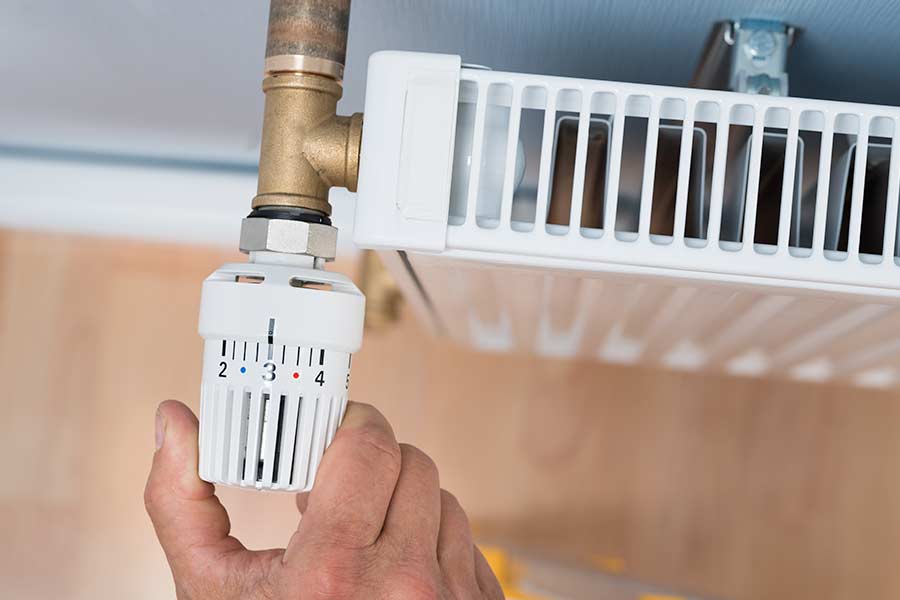Home heating advice
How to balance radiators
14 Jan 2023 • 5 minutes


Are some of the radiators in your home taking much longer to heat up than others? It’s possible that your radiators need balancing. This guide will walk you through balancing a radiator, helping restore balance in your home’s heating system.
Unbalanced radiators don’t heat up at the same speed as each other, making some areas of your house colder than others. It means the hot water flowing from your boiler is not being distributed evenly and it can become an issue during these freezing winter nights when you need heat, like, NOW.
If you find that some of your radiators are showing cold spots in certain patches across their surface, you’ll need to bleed them first. Here’s our full guide on how to bleed a radiator.
When you balance radiators, you’re allowing more water to flow to the colder radiators in your home, restricting the flow from radiators which are too hot. If some rooms are colder than others, it may mean that some radiators are heating up faster than others.
So if your radiators aren’t working properly and you’re not sure whether to bleed or balance them, do both. Let’s sort out the problem for you.
You need to know the three main types to fix this issue:
This is the old-fashioned type that you can use to turn your radiator on and off. It’s also called a wheelhead or control valve. It’s only got two positions – on or off – so that’s the only control you have over the amount of hot water flowing into your radiator.
Most modern radiators have a thermostatic valve instead of a manual. It looks like a dial with numbers on it
As the name implies, they have their own thermostat so that once the surrounding temperature reaches your desired level, the valve regulates the hot water flow into the radiator and only uses as much energy as needed. Keep TRVs away from your general room/house thermostat – if they’re in the same room they will interfere and compete with each other.
This is the one covered by a small domed plastic cap and it looks like you can’t really do much with it. In fact, you need to use grips of some kind to pull off the plastic cap. Some have a screw through the top of the cap that must be removed before the plastic bit can be pulled off. Underneath the cap it looks like the end of a flat-head screwdriver.
Follow these 10 steps to balance the radiators in your home:
Bleed radiators that have cold spots and then check that they’re now heating up all over the surface of the radiator.
Switch it off completely and allow all your radiators to cool down.
Do this on a piece of paper (or a spreadsheet if you prefer). You’ll need this later once you’ve opened all the valves.
Now open BOTH radiator valves on each radiator completely, by turning them anti-clockwise (to the left). For manual valves and TRVs it’s easy to do by hand. For Lockshield valves, remove the plastic cap (instructions above) and turn the metal valve anti-clockwise with a Lockshield valve adjuster or an adjustable spanner.
Turn the heating back on and walk around your house with your radiator list. This will help you find the radiator that heats up first. The most likely candidate is the one closest to your boiler. You might want to recruit your partner or kids to help you do this bit or you’ll be warming up pretty fast yourself! Now give each radiator on your list a number in order of how fast they started to heat up.
Once you’ve turned the heating off, check all your radiators have cooled down completely and then switch your central heating back on again. We promise you’re halfway there! – and it’s going to be worth it…
Go to the fastest heating radiator on your list and turn the Lockshield valve clockwise until it’s completely closed and then open it by a quarter of a turn.
Once the radiator has heated up, take a temperature reading. Take the reading right at the pipework connected to the Lockshield valve, where it meets the floor or wall.
Now take the temperature of the pipework leading to the manual valve/TRV. Slowly open the Lockshield valve until the temperature reading is around a 12-degree Celsius difference from the Lockshield valve reading you took in step. Please note, this will need to be in accordance with the manufacturer’s instructions.
Do this for the rest of your radiators and balance is restored!
Periodically check if your radiators are heating up at roughly the same rate. If not, balance again. Now you know how to do it, your boiler will be distributing heat evenly and you can look forward to an evenly heated home every morning and evening.
Some examples of when a heating system may require balancing are:
Do you need a one-off repair to fix the cold radiators in your home? You can count on our expert repairs team to get things working again in no time.
Our help & advice articles cover Plumbing, Home heating, Electrical, Energy-saving and Home maintenance.